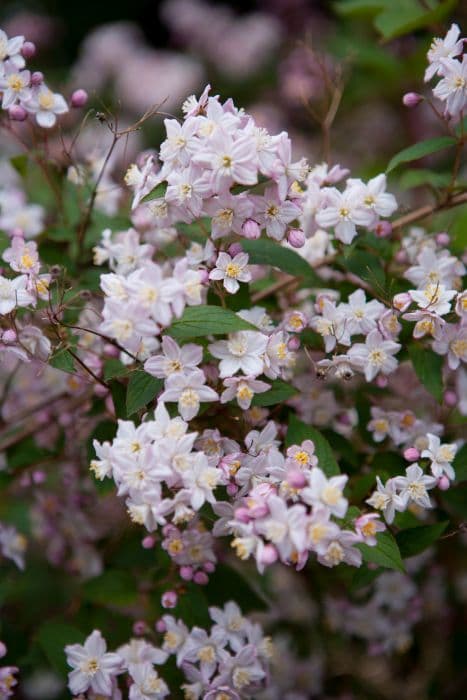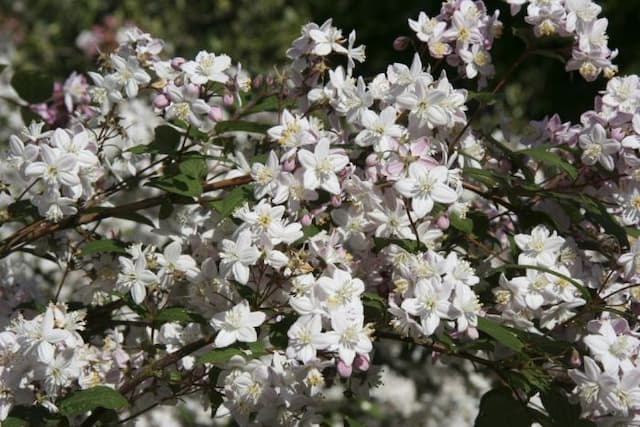Lacecap Hydrangea Hydrangea macrophylla 'Blaumeise' (Teller Series) (L)

ABOUT
The Hydrangea 'Blaumeise', often referred to as a Lacecap Hydrangea, is noteworthy for its showy appearance characterized by distinctive flowers. The blooms are a captivating feature of the plant; they present themselves as large, flat flower heads consisting of a center of small, tightly clustered blossoms surrounded by a halo of larger, more open flowers that resemble stars. These two types of flowers together create a lace-like effect, hence the common name Lacecap. The color of the blossoms can vary based on the soil acidity, ranging from blue in acidic soils to pink in more alkaline conditions. The leaves of the 'Blaumeise' are equally impressive. They are deep green, ovate in shape with serrated edges, and have a lush, glossy appearance. The overall foliage provides a dense backdrop that makes the contrasting flower heads stand out even more. As the seasons change, the plant may also take on a striking autumnal hue, with the leaves displaying vibrant tones before shedding. The stems of the 'Blaumeise' Hydrangea are strong and sturdy, supporting the weight of the heavy blooms. They tend to arch slightly under the load, creating an elegant and slightly weeping look for the plant. The overall growth habit contributes to its appeal as both a specimen plant and as part of a mixed border in a garden setting.
About this plant
 Names
NamesFamily
Hydrangeaceae
Synonyms
Lacecap Hydrangea, Mophead Hydrangea, Hortensia, Blaumeise Hydrangea
Common names
Hydrangea macrophylla 'Blaumeise'.
 Toxicity
ToxicityTo humans
The common name of Hydrangea macrophylla 'Blaumeise' is hydrangea. Hydrangeas are considered to be mildly toxic if ingested. The plant contains compounds that can release cyanide when chewed or digested. Symptoms of hydrangea poisoning may include stomach upset, nausea, vomiting, and diarrhea. In some cases, more severe symptoms such as dizziness, confusion, and increased heart rate could occur if large amounts are consumed. It is advised to avoid ingestion and to consult medical help if symptoms appear.
To pets
The common name of Hydrangea macrophylla 'Blaumeise' is hydrangea. Hydrangeas are toxic to pets such as cats and dogs. The plant contains cyanogenic glycosides, which can release cyanide when chewed or digested. Symptoms of poisoning in pets can include vomiting, diarrhea, lethargy, and depression. The severity of the toxicity can vary based on the amount ingested. Ingestion of hydrangeas warrants prompt veterinary attention.
 Characteristics
CharacteristicsLife cycle
Perennials
Foliage type
Deciduous
Color of leaves
Green
Flower color
Blue
Height
3-6 feet (0.9-1.8 meters)
Spread
3-6 feet (0.9-1.8 meters)
Plant type
Shrub
Hardiness zones
5-9
Native area
Japan
Benefits
 General Benefits
General Benefits- Aesthetic Appeal: Hydrangea 'Blaumeise' has large, attractive blooms that add a splash of color to gardens and landscapes.
- Ease of Cultivation: It is relatively easy to grow and can thrive in a wide range of soils with proper care.
- Versatility in Landscaping: This hydrangea can be used in a variety of ways, including in borders, as a focal point, or in mass plantings.
- Pollinator Friendly: The flowers attract bees and other pollinators, supporting local ecosystems.
- Seasonal Interest: It provides visual interest from spring through fall, with the ability to change bloom color based on soil pH.
- Cut Flowers: Blooms are ideal for making fresh floral arrangements and can be dried for long-term decoration.
- Screening: Mature plants can form dense shrubs, providing privacy and screening in gardens.
- Cultural Significance: Hydrangeas are often associated with heartfelt emotions and gratitude, making them meaningful additions to gardens.
 Medical Properties
Medical PropertiesThis plant is not used for medical purposes.
 Air-purifying Qualities
Air-purifying QualitiesThis plant is not specifically known for air purifying qualities.
 Other Uses
Other Uses- The dried flower heads of Hydrangea macrophylla can be used to create long-lasting arrangements in floral crafts. After the flowers have naturally faded in the autumn, they can be cut and allowed to dry for decorative purposes.
- Pressed Flower Art: The colorful blooms of the Hydrangea can be pressed and preserved to create beautiful artwork or to decorate cards and stationary.
- Natural Dyes: The petals of Hydrangeas contain pigments that can be used to create natural dyes for fabric, yarn, and paper projects, yielding a variety of colors depending on the pH of the soil they were grown in.
- Garden Borders: Hydrangeas can be planted in rows to create picturesque borders along walkways or to define different areas within a garden.
- Shelter for Small Wildlife: Dense foliage of the Hydrangeas can provide shelter and nesting opportunities for small wildlife such as birds and beneficial insects.
- Support for Climbing Plants: Taller varieties of Hydrangeas can support lighter climbing plants or vines that might need a little help in getting off the ground.
- Photography Backdrops: The lush blooms of the Hydrangea provide a stunning backdrop for outdoor photography, especially weddings and garden-themed photo shoots.
- Mood Setting: Hydrangeas can be used to set a romantic or tranquil mood in garden settings, due to their soothing colors and soft, voluminous clusters of flowers.
- Educational Use: In botany classes or children's gardening clubs, Hydrangeas can be used to illustrate the impact of soil pH on flower color and to teach about plant biology.
- Companion Planting: Horticulturists may plant Hydrangeas among other shade-loving plants to create a varied and visually appealing understory in woodland gardens.
Interesting Facts
 Feng Shui
Feng ShuiThe lacecap hydrangea is not used in Feng Shui practice.
 Zodiac Sign Compitability
Zodiac Sign CompitabilityThe lacecap hydrangea is not used in astrology practice.
 Plant Symbolism
Plant Symbolism- Heartfelt and Sincere Emotions: The Hydrangea, particularly this cultivar, often symbolizes deep feelings that are heartfelt and honest. The lushness of its blooms reflects the abundance of emotions.
- Gratitude: Gifting Hydrangeas can be an expression of thanks, making them a popular choice for expressing appreciation.
- Apology and Forgiveness: In some contexts, giving a Hydrangea can indicate an apology or a request for forgiveness, as it can symbolize remorse and the desire to make amends.
- Vanity and Boastfulness: In some cultures, the Hydrangea can represent vanity or boastfulness due to its showy, extravagant clusters of flowers.
- Abundance and Prosperity: The voluminous blossoms of the Hydrangea signify abundance and prosperity, making it a symbol of plentifulness and growth.
- Understanding: The wide range of colors and the delicate balance of the Hydrangea's flowers can stand for comprehension and deeper understanding between people.
- Perseverance: The Hydrangea's ability to bloom in a variety of soil types and conditions can represent endurance and the ability to persist through challenges.
 Water
WaterLacecap hydrangeas, including Hydrangea macrophylla 'Blaumeise', prefer consistently moist soil, so regular watering is important, especially during dry spells. It's recommended to water deeply once a week, providing about one to one and a half gallons per plant each time, depending on the weather conditions. During hot or windy weather, you may need to water more frequently to keep the soil from drying out. It's best to water at the base of the plant to keep moisture off the leaves and flowers, which can help prevent disease. Be cautious to not overwater as this can lead to root rot.
 Light
LightLacecap hydrangeas like Hydrangea macrophylla 'Blaumeise' thrive in partial shade, benefiting from morning sun and afternoon shade. A location that offers protection from harsh midday sun is ideal, as too much direct sunlight can scorch their leaves and blooms. An eastern-facing spot that gets gentle sunlight in the morning and is shaded during the hotter parts of the day would be the best spot for this plant.
 Temperature
TemperatureLacecap hydrangeas, such as the Hydrangea macrophylla 'Blaumeise', grow well in temperatures that range from about 60 to 75 degrees Fahrenheit. They can survive minimum temperatures in the winter as low as 30 degrees Fahrenheit but should be protected from prolonged freezing conditions. During summer, if temperatures frequently exceed 80 degrees Fahrenheit, providing some afternoon shade can help keep the plant cooled.
 Pruning
PruningPruning lacecap hydrangeas like Hydrangea macrophylla 'Blaumeise' is necessary to remove dead wood and encourage new growth. Prune right after blooming has finished, usually in late summer or early fall, as the plant blooms on old wood. Remove only dead or weak stems, and avoid cutting back more than a third of the plant to prevent stress.
 Cleaning
CleaningAs needed
 Soil
SoilThe best soil mix for Lacecap Hydrangea is rich, porous, moist, and well-draining soil with a pH of around 5.5 for blue flowers. A mix of garden soil, compost, and peat moss is ideal.
 Repotting
RepottingLacecap Hydrangeas should be repotted every 2 to 3 years or when they outgrow their current pot to ensure continued health and growth.
 Humidity & Misting
Humidity & MistingLacecap Hydrangea thrives in average to high humidity levels, ideally around 60% to ensure vigorous growth and lush foliage.
 Suitable locations
Suitable locationsIndoor
Place in bright, indirect light; water thoroughly when topsoil is dry.
Outdoor
Plant in morning sun, afternoon shade; water deeply and mulch.
Hardiness zone
5-9 USDA
 Life cycle
Life cycleThe life cycle of the Hydrangea macrophylla 'Blaumeise', commonly known as Lacecap Hydrangea, begins with seed germination, which requires warm temperatures and moist soil. Following germination, the seedling stage involves the development of roots and the first set of true leaves. As the plant enters the vegetative stage, it grows larger leaves and stems, establishing a strong root system and potentially lasting several years as it matures. The next stage is the flowering phase, where it produces its distinctive blue or pink lacecap flowers in early to mid-summer, depending on soil pH and climate. After pollination, the plant forms seed capsules, completing its reproductive cycle. Finally, the hydrangea enters dormancy during the winter, with its above-ground parts dying back, while the root system remains alive to enable new growth in the subsequent spring.
 Propogation
PropogationPropogation time
Spring to Summer
Propogation: The Hydrangea macrophylla 'Blaumeise', more commonly known as the Teller Blue Hydrangea, is typically propagated by softwood cuttings. The best time for taking cuttings is in early summer when new growth is still tender and flexible. To propagate, a healthy stem is selected, and a cutting of about 5 to 6 inches (approximately 13 to 15 centimeters) is made just below a leaf node. The lower leaves are removed, and the cut end can be dipped in rooting hormone to encourage root development. Then, the cutting is placed in a well-draining potting mix, ensuring that at least one set of leaf nodes is below the surface. The pot is kept moist and in a location with indirect light until roots have developed, which could take several weeks. Once rooted, the hydrangea can be transplanted into the garden or a larger container.








![Hydrangea [Early Sensation]](/_next/image?url=https%3A%2F%2Fplants-admin.emdemapps.com%2Fimages%2Fplants%2F%2Fimages%2F604b6150338db.png&w=640&q=75)
